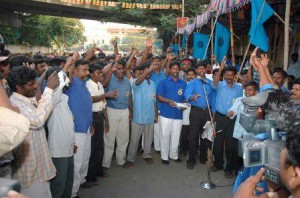Parliament passes Anti-Manual Scavenging Bill

The Lok Sabha passed a historic bill to put an end to manual scavenging in India. Manual Scavenging-the practice of clearing of human waste by hand from toilets is no banned and employment of scavengers is outlawed. Help will also be provided for retraining and for their families. In India, the problem of manual scavenging has become a major hindrance towards inclusive development and growth of all citizens. The practice of manual scavenging is a violation of the rights guaranteed under Art.14, 17, 21 and 47 but approximately 12 lakh people are employed in the trade, 95% of them being Dalits. Government bodies such as Railways, PSUs and Army also employ them informally.
Sequence of events-
In 1992, National scheme for rehabilitation of Manual scavengers.
In 2003, CAG notes that despite spending 600 crore on various schemes, no progress was made.
In 1993, National Commission for Safai Karmachari
In 1993, Dry latrine prohibition Act. (Dry latrines have to be manually cleaned. So if there are no dry laterines, then manual scavenging will also vanish but this did not happen.)
In 1997, Dry latrine prohibition Act implemented in some states.
In 2003, Mandamus by petition by Safai Karamchari Andolan.
In 2013, Government enacted new law.
In 2014, SC delivered verdict on the Mandamus writ with the then Chief Justice P. Sathasivam himself heading the bench.
“This dehumanising practice (of manual scavenging) is inconsistent with the right to live with dignity,” social justice minister Kumari Selja said after passage of the bill.
Manual scavenging has been linked historically to the practice of untouchability and caste system which was first sought to be ended through Employment of Manual Scavengers and Construction of Dry Latrines (Prohibition) Act, 1993. As per the 2011 Census, about 23 lakh pit latrines (which are insanitary latrines) continue to exist in the country.
Offenses under the Bill are cognizable and non-bailable and may be tried summarily.
Summary of the bill is as under;
| Each occupier of an insanitary latrine is responsible for converting or demolishing it at his own cost. If he fails to do so, the local authority will convert the latrine and recover the cost from him.Existing contracts with manual scavengers shall be void once the law is in force. | State governments may provide assistance to occupiers for converting latrines. However, non-receipt ofassistance shall not be a valid ground to use an insanitary latrine beyond nine months of the law in force. | Every local authority (municipality, Panchayat, cantonment board or railway authority) has to carry out asurvey of insanitary latrines within its jurisdiction. The authorities have to publish a list of such latrineswithin two months of the law coming into force and give notice to the occupiers to either demolish or convertthem into sanitary latrines within six months. | All persons listed as manual scavengers shall be rehabilitated with a one time cash assistance, scholarship fortheir children, and a residential plot with financial assistance for constructing a house. One adult member ofthe family will be trained in a livelihood skill and given a monthly stipend of at least Rs 3,000 duringtraining. |
| Offences under the Bill shall be non-bailable, and maybe tried summarily. The penalty for employing manual scavengers or failing to demolish insanitary latrines is imprisonment ofone year and/or a fine of Rs 50,000 for the first offence. Subsequent offences will be punished withimprisonment up to two years and/or a fine of Rs one lakh. | The Bill creates provisions for the construction of an adequate number of sanitary community latrines and theuse of appropriate technological appliances for cleaning sewers and septic tanks. | The state government may appoint inspectors. They shall be responsible for examining premises for latrines,persons employed as manual scavengers and seizing relevant records. | The bill has more stringent provisions than the 1993 act which had proved to be ineffective in curbing this practise. |
Reference and further reading;
“Availability and type of latrine facility”, Census of India 2011.

